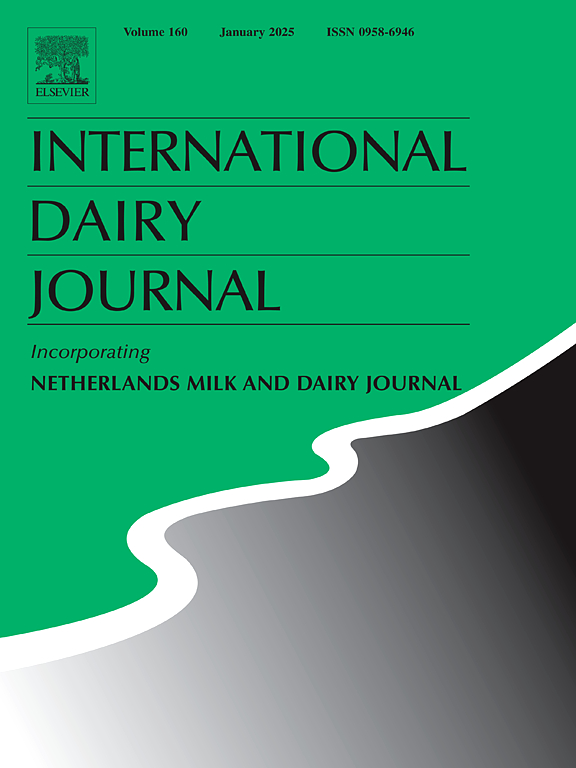Influence of minor β-CN genotypes on coagulation properties and proteolytic pathways of bovine milk
IF 3.4
3区 农林科学
Q2 FOOD SCIENCE & TECHNOLOGY
引用次数: 0
Abstract
Numerous studies have examined the effects of the two most common β-casein (β-CN) genetic variants, A1 and A2, on the physicochemical and functional properties of bovine milk. However, relatively minor variants of this protein such as B and I remain under-researched. This study collected milk with four β-CN genotypes, A1B, A2B, A1I, and A2I, across three collection occasions to investigate their functional and proteolytic properties. Milk of the B variant exhibited similar behaviour to A1 regarding rennet and acid coagulation properties, while I was similar to A2. Furthermore, the Glu121-Arg122 and Arg122-Gln123 bonds in the β-CN B variant were more sensitive to plasmin-derived proteolysis than Ser122 in other variants, leading to more peptides from cleavage at Arg122-related sites. These findings support grouping genotypes based on the amino acid (AA) at position 67, as variants sharing the same AA at this position exhibit similar processability, while also highlighting the significant impact of AA at position 122 for proteolysis in milk or dairy products.
少量β-CN基因型对牛乳凝固特性和蛋白水解途径的影响
许多研究已经检验了两种最常见的β-酪蛋白(β-CN)基因变异A1和A2对牛乳理化和功能特性的影响。然而,这种蛋白质的相对较小的变体,如B和I,仍未得到充分研究。本研究收集了四种β-CN基因型(A1B、A2B、A1I和A2I)的牛奶,通过三次收集来研究它们的功能和蛋白水解特性。B变体的牛奶在凝血酶和酸凝固性能方面表现出与A1相似的行为,而I与A2相似。此外,β-CN B变体中的Glu121-Arg122和Arg122-Gln123键比其他变体中的Ser122对纤溶蛋白衍生的蛋白水解更敏感,导致在arg122相关位点切割更多的肽。这些发现支持基于67位氨基酸(AA)的基因型分组,因为在该位置共享相同AA的变异具有相似的可加工性,同时也强调了122位AA对牛奶或乳制品中蛋白质水解的重要影响。
本文章由计算机程序翻译,如有差异,请以英文原文为准。
求助全文
约1分钟内获得全文
求助全文
来源期刊

International Dairy Journal
工程技术-食品科技
CiteScore
6.50
自引率
9.70%
发文量
200
审稿时长
49 days
期刊介绍:
The International Dairy Journal publishes significant advancements in dairy science and technology in the form of research articles and critical reviews that are of relevance to the broader international dairy community. Within this scope, research on the science and technology of milk and dairy products and the nutritional and health aspects of dairy foods are included; the journal pays particular attention to applied research and its interface with the dairy industry.
The journal''s coverage includes the following, where directly applicable to dairy science and technology:
• Chemistry and physico-chemical properties of milk constituents
• Microbiology, food safety, enzymology, biotechnology
• Processing and engineering
• Emulsion science, food structure, and texture
• Raw material quality and effect on relevant products
• Flavour and off-flavour development
• Technological functionality and applications of dairy ingredients
• Sensory and consumer sciences
• Nutrition and substantiation of human health implications of milk components or dairy products
International Dairy Journal does not publish papers related to milk production, animal health and other aspects of on-farm milk production unless there is a clear relationship to dairy technology, human health or final product quality.
 求助内容:
求助内容: 应助结果提醒方式:
应助结果提醒方式:


